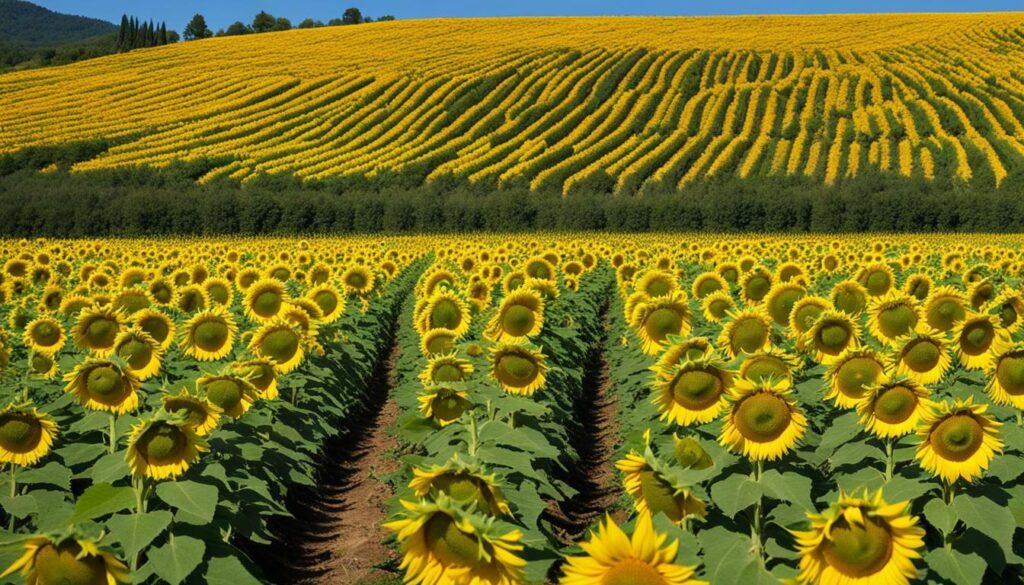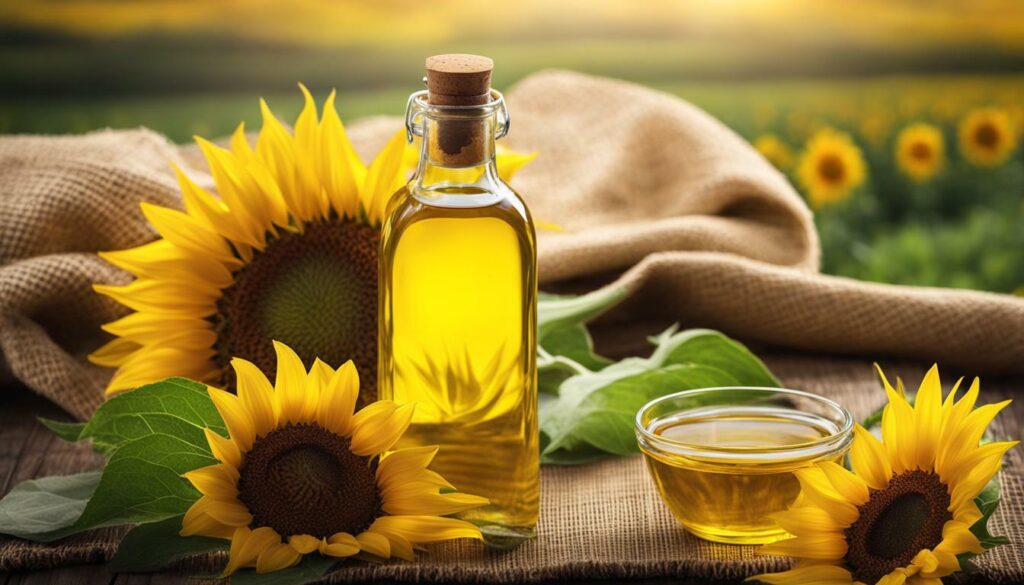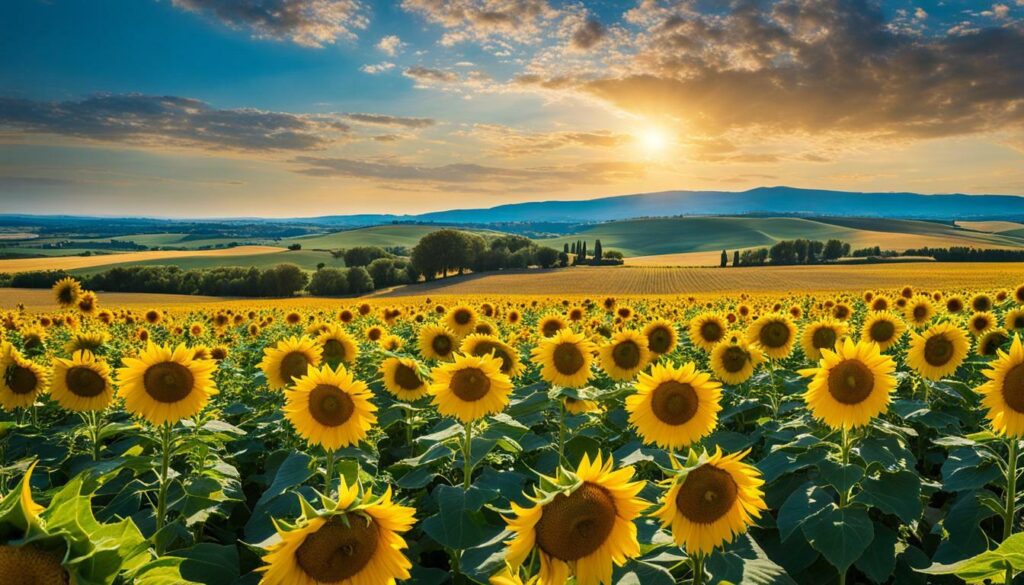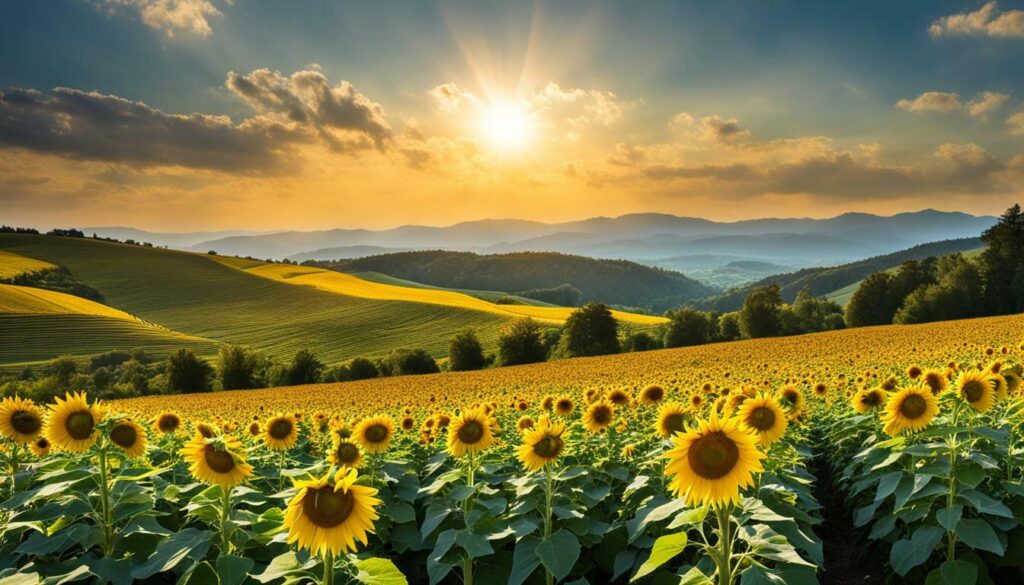Welcome to the stunning beauty of France’s Champ de Tournesol, where vibrant sunflower fields stretch as far as the eye can see. This picturesque sight in Provence, France, is a true feast for the senses. The sunflower, often referred to as the “sun of the gardens,” is known for its tall stature and its ability to turn with the sun throughout the day. These yellow flowers hold a special significance, not just for their visual appeal, but also for their use in the production of sunflower oil.
Sunflower oil is considered one of the healthiest and most nutritious oils, alongside canola and olive oil. It is rich in essential fatty acids and vitamin E, making it beneficial for cardiovascular health and preventing premature cell aging. The versatility of sunflowers extends beyond oil production, as their seeds are also a great source of energy. They can be enjoyed in various ways, whether as a spread, in salads, or as a topping.
The sunflower season in France typically begins in late June and reaches its peak in early to mid-July, coinciding with the enchanting blooming of the purple lavender fields. The combination of the vibrant sunflowers against the picturesque lavender backdrop creates a truly mesmerizing experience.
If you’re planning to witness the beauty of sunflower fields in Provence, the best places to visit are Valensole and the villages of the Luberon region. These locations offer breathtaking views and ample opportunities for capturing stunning photographs.
The surge in sunflower cultivation in France can be attributed to the conflict with Russia, which has led to farmers shifting from maize to sunflowers. This transition is driven by the lower resource requirements of sunflower cultivation, making it a more sustainable and eco-friendly option.
Join me as we delve deeper into the captivating world of Champ de Tournesol and explore the significance of sunflowers in Provence, France.
Exploring the Sunflower Fields of Provence
Immerse yourself in the mesmerizing beauty of Provence’s sunflower fields, where nature’s artistry unfolds in vibrant hues of yellow and green. Spread across the picturesque landscape, these sunflower fields in Provence, France, are a sight to behold. As the warm summer breeze gently rustles the towering sunflowers, it creates a scene straight out of a postcard.
Walking through these fields is like stepping into a sea of golden petals, with the sunflowers swaying gracefully in the sun’s gentle rays. The awe-inspiring sight of endless rows of sunflowers stretching as far as the eye can see is truly a feast for the senses. The sheer magnitude and vibrancy of the sunflower fields evoke a sense of tranquility and wonder, igniting a feeling of joy and appreciation for the beauty of nature.
During the sunflower season, which typically begins in late June and reaches its peak in early to mid-July, the sunflower fields in Provence come alive with the vibrant colors of yellow and green. The sunflowers’ cheerful faces turn towards the sun, following its path throughout the day, giving rise to their nickname, “sun of the gardens.” This natural phenomenon adds to the allure of the sunflower fields, creating a magical and captivating experience for visitors.

As you explore these sunflower fields, take a moment to admire the intricate details of each sunflower’s petals, the way they follow the sun’s trajectory, and the symphony of buzzing bees and fluttering butterflies that grace the fields. Let the beauty and serenity of the sunflower fields in Provence transport you to a place of tranquility and appreciation for the wonders of nature.
Exploring the Sunflower Fields: A Visual Delight
| Location | Best Time to Visit |
|---|---|
| Valensole | Late June to mid-July |
| Luberon region villages | Early to mid-July |
To make the most of your visit, head to Valensole and the surrounding villages in the Luberon region during late June to mid-July. These locations offer some of the best views of the sunflower fields, providing ample opportunities for capturing stunning photographs and immersing yourself in the beauty of Provence’s sunflower season.
So, if you find yourself in Provence during the summer months, don’t miss the chance to witness the breathtaking charm of the sunflower fields. Prepare to be captivated by their vibrant colors, enchanting fragrance, and the sense of awe that comes with standing amidst these natural wonders.
The Significance of Sunflowers
Beyond their remarkable beauty, sunflowers play a vital role in our lives, especially through the extraction of sunflower oil, a nutritious powerhouse that offers numerous health benefits. Sunflower oil is known for its high content of essential fatty acids and vitamin E, making it a heart-healthy choice and an effective tool in preventing premature cell aging.
In addition to being a versatile cooking oil, sunflower oil also provides a range of health benefits. The essential fatty acids found in sunflower oil are necessary for our bodies to function properly. They help reduce inflammation, lower cholesterol levels, and support brain health. Vitamin E, another key component of sunflower oil, acts as a powerful antioxidant, protecting our cells from damage caused by free radicals.
But sunflowers’ contributions to our well-being don’t stop at oil. Sunflower seeds, packed with essential nutrients, are a delicious snack and a great source of energy. These small powerhouses are filled with protein, fiber, healthy fats, and important minerals such as magnesium, potassium, and zinc. They can be enjoyed on their own, added to salads, or used in spreads, making them a versatile and nutritious addition to any diet.

Sunflower Oil and Its Health Benefits
Sunflower oil, with its abundant reserves of essential fatty acids and vitamin E, boasts a remarkable array of health benefits, ranging from supporting heart health to keeping our cells youthful and vibrant. The essential fatty acids, such as omega-6 and omega-9, found in sunflower oil are crucial for maintaining a healthy cardiovascular system. These fatty acids help reduce bad cholesterol levels and promote good cholesterol levels, thereby minimizing the risk of heart disease and stroke.
Vitamin E, a potent antioxidant present in sunflower oil, plays a vital role in protecting our cells from oxidative stress and premature aging. It helps to neutralize harmful free radicals and supports the development of healthy skin, hair, and nails. Additionally, vitamin E has been linked to improved immune function, which can help defend against various diseases and infections.
Incorporating sunflower oil into our diet not only enhances the taste of our meals but also provides numerous health benefits. It is important to note that moderation is key when consuming sunflower oil, as it is high in calories. However, when used in moderation as part of a balanced diet, sunflower oil can be a valuable addition to our culinary repertoire, offering both flavor and nutritional benefits.
To fully appreciate the benefits of sunflower oil, it is essential to choose a high-quality, cold-pressed variety that has been minimally processed. This ensures that the oil retains its natural goodness and nutritional properties. Whether used for cooking, salad dressings, or baking, sunflower oil can elevate the taste and nutritive value of a wide range of dishes.
| Health Benefits of Sunflower Oil: | How It Supports Our Well-being: |
|---|---|
| Cardiovascular Health | Reduces bad cholesterol levels and promotes good cholesterol levels |
| Premature Aging Prevention | Protects cells from oxidative stress and supports youthful skin, hair, and nails |
| Enhanced Immune Function | Improves immune response and defense against diseases |

With its numerous health benefits and versatility in the kitchen, sunflower oil is a valuable addition to any culinary repertoire. Incorporate this golden oil into your cooking and experience the flavorful and nutritious advantages it offers. Remember, a little goes a long way, so enjoy it in moderation for optimal health and well-being.
Sunflower Seeds: A Nutritious Superfood
Bursting with vitality, sunflower seeds are a nutritional powerhouse, providing a natural source of energy and a delightful addition to a variety of dishes. These small but mighty seeds are packed with essential nutrients, making them a popular choice for health-conscious individuals.
Not only are sunflower seeds rich in healthy fats, fiber, and protein, but they also contain a wide range of vitamins and minerals. They are particularly high in vitamin E, an antioxidant that plays a crucial role in supporting immune function and protecting cells from damage.
When it comes to culinary uses, sunflower seeds are incredibly versatile. They can be enjoyed on their own as a snack, added to salads for an extra crunch, or incorporated into baked goods for added texture and flavor. They can also be ground into a creamy spread, similar to peanut butter, or used as a topping for yogurt, oatmeal, or smoothie bowls. The possibilities are endless!
So next time you’re looking for a healthy and delicious addition to your meals or snacks, consider incorporating sunflower seeds. Not only will you be adding a burst of flavor and texture to your dishes, but you’ll also be reaping the nutritional benefits of these tiny but mighty seeds.

| Nutrient | Amount per 100g |
|---|---|
| Calories | 584 |
| Protein | 20.78g |
| Fat | 51.46g |
| Carbohydrates | 20.00g |
| Fiber | 8.6g |
| Vitamin E | 35.17mg |
| Magnesium | 325mg |
| Zinc | 5mg |
Sunflowers and Lavender: A Perfect Pairing in Provence
When the sunflower season coincides with the blooming lavender fields of Provence, a harmonious symphony of golden sunflowers and vibrant purple lavenders creates an awe-inspiring sight. The picturesque landscapes of Provence are transformed into a canvas of contrasting colors, captivating the hearts of both locals and visitors alike.
The sunflower season in Provence typically begins in late June, as the sunflower fields come to life with rows upon rows of tall, sturdy stems adorned with cheerful yellow flowers. As the season progresses and reaches its peak in early to mid-July, these sunflowers stand tall and proud, their faces turned towards the sun, basking in its warm rays. Alongside them, the lavender fields burst into bloom, releasing their intoxicating fragrance into the air.
Provence is renowned for its lavender production, and the combination of sunflowers and lavender creates a truly magical spectacle. These two iconic symbols of the region complement each other perfectly, creating a visual symphony that is both breathtaking and unforgettable. The vibrant hues of the sunflowers dance in harmony with the delicate beauty of the lavender, creating a sensory experience that is nothing short of extraordinary.
Sunflowers and Lavender: A Perfect Blend
Not only do sunflowers and lavender create a stunning visual display, but they also offer a feast for the senses. The vibrant colors and gentle fragrance of lavender blend seamlessly with the radiant beauty and cheerful demeanor of the sunflowers. This combination of nature’s artistry is a true testament to the wonders of Provence.
| Sunflowers | Lavender |
|---|---|
| Symbol of happiness and vitality | Symbol of serenity and tranquility |
| Rich yellow color | Pure purple color |
| Large, bold flowers | Fragrant, delicate flowers |
As you immerse yourself in the sunflower season and explore the lavender fields of Provence, take a moment to appreciate the beauty and significance of these two natural wonders. Let their colors and fragrances fill your senses, and allow yourself to be swept away by the magic of this perfect pairing.

Witnessing the blooming sunflower fields and lavender meadows in Provence is an experience that will forever be etched in your memory. The golden sunflowers and vibrant purple lavenders create a captivating sight that celebrates the beauty of nature and the bountiful treasures found in the heart of Provence, France.
Best Places to See Sunflower Fields in Provence
If you’re planning a trip to Provence to bask in the glory of sunflower fields, be sure to explore Valensole and the charming villages scattered throughout the picturesque Luberon region. These locations offer a breathtaking spectacle during the sunflower season, with vast expanses of golden blooms stretching as far as the eye can see.
Valensole, located in the Alpes-de-Haute-Provence department, is renowned for its sunflower fields that adorn the rolling hills. The vibrant yellow petals contrast beautifully with the blue sky, creating a truly mesmerizing landscape. Take a leisurely stroll through the fields, immerse yourself in the tranquility of nature, and capture the perfect postcard-worthy moment.
In addition to Valensole, the Luberon region is home to several villages that showcase the splendor of sunflower fields. Explore the charming streets of Gordes, Roussillon, and Menerbes, where you’ll find fields bursting with sunflowers nestled against the backdrop of historic architecture and breathtaking scenery.
Sunflower Fields in Valensole
| Location | Best Time to Visit |
|---|---|
| Valensole Plateau | Mid-June to Mid-July |
| Route de Puimichel | Early July |
| Chemin des Lauriers Roses | Mid-July |
Marvel at the vastness of the Valensole Plateau, where endless fields of sunflowers create an awe-inspiring sight. Capture the beauty of nature as the sunflowers sway in the gentle breeze, creating a mesmerizing dance of color. The Route de Puimichel and Chemin des Lauriers Roses also offer idyllic spots to immerse yourself in the golden sea of sunflowers.
Whether you’re a nature enthusiast, a photography lover, or simply seeking a peaceful retreat, the sunflower fields in Valensole and the Luberon region are a must-visit destination. Prepare to be captivated by the breathtaking beauty of these sun-kissed landscapes, where the vibrant colors of Provence come to life.

The rise of sunflower cultivation in France can be attributed to the conflict with Russia, which has led farmers to transition from maize crops to sunflower fields, benefitting from its more efficient resource utilization. As tensions between the two countries escalated, French farmers sought alternative crops that required fewer resources and had a higher market demand.
Sunflowers proved to be an ideal choice as they are well-suited to the French climate and soil conditions. They thrive in warm and sunny environments, making Provence an ideal region for their cultivation. Not only do sunflowers require less water and fertilizer compared to maize, but they also offer multiple benefits to both the environment and the farmers.
One of the primary advantages of sunflower cultivation is its eco-friendly nature. Sunflowers have deep root systems that help improve soil structure and prevent erosion, making them an excellent choice for sustainable agriculture. Additionally, sunflowers play a crucial role in promoting biodiversity, attracting beneficial insects and pollinators to the fields.
The shift towards sunflower cultivation has been a win-win situation for French farmers. They not only reduce their dependency on resource-intensive maize crops but also tap into the growing market demand for sunflower oil and seeds. With its numerous health benefits and culinary versatility, sunflower oil has gained popularity among health-conscious consumers. Sunflower seeds, on the other hand, are increasingly recognized as a nutritious superfood, providing a natural source of energy and essential nutrients.
| Advantages of Sunflower Cultivation | |
|---|---|
| 1. Resource-efficient: Requires less water and fertilizer compared to maize | |
| 2. Eco-friendly: Improves soil structure, prevents erosion, and promotes biodiversity | |
| 3. Market demand: Sunflower oil and seeds have gained popularity for their health benefits |

The rise of sunflower cultivation in France, driven by the conflict with Russia, has not only brought stunning landscapes of colorful sunflower fields but also provided French farmers with a viable alternative to maize crops. The transition to sunflower cultivation offers resource efficiency, eco-friendly practices, and access to a growing market demand for sunflower oil and seeds. As the sunflower industry continues to flourish, it stands as a testament to the adaptability and resilience of French farmers in the face of agricultural challenges.
The Eco-Friendly Benefits of Sunflower Cultivation
Beyond their visual allure, sunflower fields also contribute to sustainable agriculture, as their cultivation brings forth a multitude of eco-friendly benefits. Sunflowers are known for their ability to absorb harmful substances from the soil, making them natural agents for soil remediation and detoxification. They have been used in phytoremediation projects to remove heavy metals and pollutants from contaminated areas, effectively purifying the soil and improving its quality for future agriculture.
In addition to their soil-cleansing properties, sunflowers play a crucial role in promoting biodiversity. The bright yellow flowers attract bees, butterflies, and other pollinators, supporting the ecological balance of the surrounding area. By providing a habitat for beneficial insects and pollinators, sunflower fields contribute to the overall health of the ecosystem and help maintain a diverse and thriving agricultural landscape.
Furthermore, sunflower cultivation promotes sustainable practices by requiring minimal water usage. Compared to other crops, sunflowers are relatively drought-tolerant and can thrive in arid and semi-arid regions with limited water resources. This makes them an ideal choice for farmers seeking to reduce their water footprint and practice sustainable agriculture.
| Eco-Friendly Benefits of Sunflower Cultivation |
|---|
| Soil remediation and detoxification |
| Promotion of biodiversity |
| Minimal water usage |
Overall, sunflower cultivation offers a sustainable and environmentally conscious approach to agriculture. Its ability to cleanse the soil, support pollinators, and thrive in water-scarce conditions makes it a valuable crop for farmers looking to minimize their impact on the environment. As we appreciate the beauty of sunflower fields, let us also acknowledge their role in fostering a more eco-friendly and sustainable future for agriculture.

Exploring the Champ de Tournesol in Provence is an extraordinary journey that immerses you in the captivating beauty of sunflower fields, leaving an indelible mark on your heart and soul. This picturesque sight, also known as the Sunflower Field, offers a mesmerizing display of tall sunflowers with their vibrant yellow petals stretching as far as the eye can see. Located in the enchanting region of Provence, France, this natural wonder is a must-visit destination for nature lovers and photography enthusiasts.
Not only are sunflowers visually stunning, but they also hold great significance. These majestic flowers are known as the “sun of the gardens,” thanks to their ability to turn their faces towards the sun, following its path throughout the day. A symbol of warmth, happiness, and summer, sunflowers bring joy to all who encounter them.
Furthermore, sunflowers are not only aesthetically pleasing but also a source of numerous health benefits. Sunflower oil, derived from these radiant flowers, is considered one of the healthiest and most nutritious oils. It is rich in essential fatty acids and vitamin E, making it beneficial for cardiovascular health and preventing premature cell aging. Additionally, sunflower seeds, a popular snack, are a great source of energy, packed with essential nutrients.
When visiting Provence, the best time to witness the breathtaking sunflower fields is during the sunflower season, typically from late June to early to mid-July. During this period, the vibrant yellow hues of the sunflowers blend harmoniously with the purple lavender fields, creating an enchanting fusion of colors. The Valensole plateau and the villages of the Luberon region are among the best places to witness this natural spectacle, offering picturesque landscapes that will leave you in awe.
The rise in sunflower cultivation in France can be attributed to the conflict with Russia, which has led farmers to shift from maize production to sunflowers. This transition is driven by the sunflower’s lower resource requirements and its contribution to sustainable and eco-friendly agricultural practices. As a result, the sunflower fields of Provence not only offer a scenic and awe-inspiring experience but also symbolize the resilience and adaptability of the agricultural industry.
In conclusion, a visit to the Champ de Tournesol in Provence, France, is an unforgettable experience that allows you to immerse yourself in the captivating beauty of sunflower fields. Whether witnessing the stunning sunflowers during the peak of the sunflower season or exploring the harmonious blend of colors alongside the lavender fields, the Champ de Tournesol will leave you with memories to cherish for a lifetime.
FAQ
What is Champ de Tournesol?
Champ de Tournesol is a picturesque sunflower field located in Provence, France.
Why are sunflowers called the “sun of the gardens”?
Sunflowers are called the “sun of the gardens” because their flowers have the ability to turn and face the sun as it moves across the sky.
What is sunflower oil used for?
Sunflower oil is commonly used in cooking and is considered one of the healthiest and most nutritious oils. It can be used in various culinary preparations, such as spreads, salads, and as toppings.
What are the health benefits of sunflower oil?
Sunflower oil is rich in essential fatty acids and vitamin E, which are beneficial for cardiovascular health and preventing premature cell aging.
How can sunflower seeds be enjoyed?
Sunflower seeds can be enjoyed in various ways, such as eating them plain, adding them to salads or baked goods, or using them to make spreads and butters.
When is the sunflower season in Provence?
The sunflower season in Provence typically begins in late June and reaches its peak in early to mid-July.
Where are the best places to see sunflower fields in Provence?
The best places to see sunflower fields in Provence are in Valensole and the villages of the Luberon region.
Why has sunflower cultivation increased in France?
Sunflower cultivation in France has increased due to the conflict with Russia, which has led to farmers shifting from maize to sunflower due to its lower resource requirements.
- Comment s’occuper de tulipe? - October 22, 2023
- Tulipe qui se ferme la nuit? - October 22, 2023
- Ou acheter tulipe? - October 22, 2023







